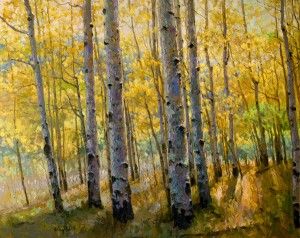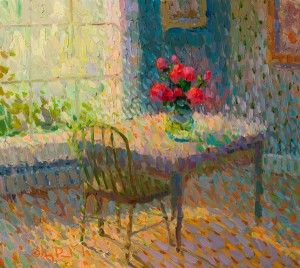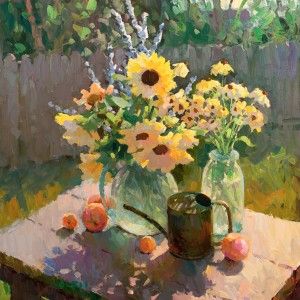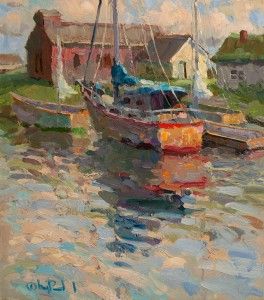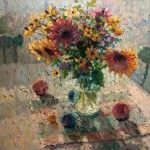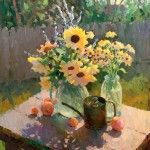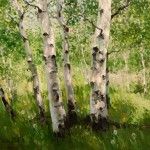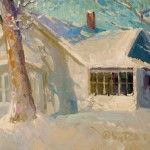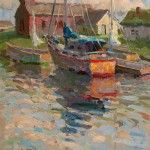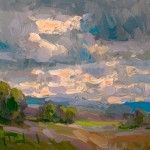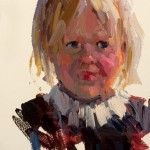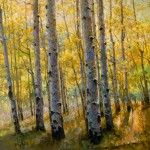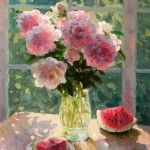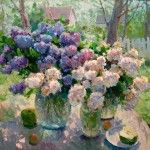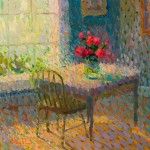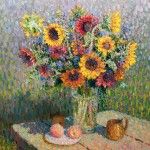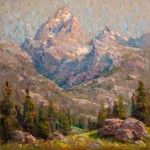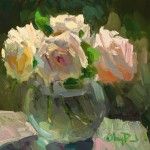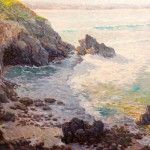Gregory Packard discovers greater poetic expression through two painting styles
By Gussie Fauntleroy
This story was featured in the August 2012 issue of Southwest Art magazine. Order the Southwest Art magazine August 2012 print edition here, or purchase the Southwest Art magazine August 2012 digital download here. Or simply click here to subscribe to Southwest Art magazine and never miss a story!
Gregory Packard slowly paddled a kayak through the ripples of Glacier Bay in southeastern Alaska. Sitting at water level, he breathed the cool, fresh air and tilted his head to take in the green mountains rising thousands of feet straight out of the water, white glaciers winding upward between them toward higher peaks. Grizzly bear, moose, whales—these were common sights for the 22-year-old Idaho native during the memorable summer he spent working at a lodge in Glacier Bay National Park, filled with the electric intensity of being surrounded by wilderness, in love with life.
“I knew that if I tipped the kayak, there was a good chance I could die. Everything was just a little more real, urgent, immediate,” Packard remembers now, 20 years later, while relaxing in his converted garage studio at the home he shares with his wife and two young children in Montrose, CO. “Painting is a lot about immediacy and the moment, and I lived that up there. I think the experience affirmed that I loved nature, but it just was on a grander scale.”
The artist carried an easel and paints to Alaska and took them out once: In the endless northern sunset one evening, he walked down the beach from the lodge and out onto a rocky point. Completely absorbed in capturing the seascape on canvas—his first-ever plein-air painting—he didn’t notice the incoming tide swiftly covering the rocks. The painting finished, he happily waded back to the beach.
That experience, combined with the powerful effect of so much wild nature surrounding him, might have hooked him on painting right then and there, but it didn’t—quite. Like a slow incubation, Packard’s desire to be an artist remained just below the surface until his late 20s, waiting for the opportunity to emerge and grow. In the meantime, circumstances arranged themselves so everything would be ready when the time came to dedicate himself to art and, eventually, to gain a broad, appreciative collector base.
Packard’s earliest memories foreshadow the twin passions that coalesced a little later in his life. He recalls holding a pencil in his 4-year-old hand, drawing and drawing. Until age 6 he also was immersed in the idyllic rural world of a farm near Boise, where the family lived until his parents divorced. “I remember wandering around the farm, building forts, playing in the haystacks, playing in the barn. I was a country kid,” he recalls. “I’ve got that in my blood and memory. I probably look back on it romantically, and it plays a part in my art.”
Through grade school and high school Packard practiced photo-realistic drawing, never trying to paint but honing his skills in black and white. In high school in Boise, he and a friend rented an office as a studio, and both drew. But his self-taught hyper-realistic style only carried the would-be artist so far. “I got to the point where I couldn’t take it to the next level, to that artistic level, so I got bored with it,” he relates.
With no direction after high school and no desire to continue working in construction for an older brother’s company, Packard tried electrical engineering at a Phoenix trade school. That wasn’t the ticket either, so he returned to Idaho and enrolled at Boise State University. Working full-time and extending his college career well beyond four years—with time off for the Alaskan adventure—he became the first member of his family to earn a degree. With an interest in writing, he majored in English but also took a couple of painting courses, gradually enhancing his skills and interest in art.
A couple of years out of high school, Packard was making a living as a technical writer. One day while he was in downtown Boise for a business meeting, he saw a poster announcing a weeklong painting workshop given by an artist whose work he admired. Then he saw another workshop advertised and decided to sign up for both, back to back. “The urge to do art had never gone away, but art schools were expensive, and I didn’t want to go into debt,” he recounts. “So when I learned about the workshops, I was elated—it was the working man’s way to do it.”
The artists leading the workshops, Robert Moore and Delbert Gish, were both heavily influenced by Russian Impressionism, and Gish had been an assistant to renowned Russian Impressionist painter Sergei Bongart. For Packard, an impressionistic approach was extraordinarily freeing after years of drawing and then trying to paint in a tightly rendered, realistic style. It opened up “a whole new can of worms,” as he jokingly puts it. “It was coarse, it was bold, it was very exciting, something I’d never seen. Now I love the French, Russian, and California Impressionists.”
This looser, freer way of painting allowed the young artist to explore deeper, more subtle, more interpretive modes of perception, and to translate onto canvas this way of seeing the world. “My own nature is truest in impressionism because it’s very intuitive,” he observes. “It’s like a poem, like capturing a glimpse, the pinpoint of a memory. It’s like seeing something and then it’s gone but you hold onto that vitality. For me, there’s more room to express myself.”
Today Packard expresses his love for the natural world in vibrant, richly hued landscapes, seascapes, and still lifes, especially florals. For a number of years his painting was characterized by a loose, traditional, wet-on-wet approach. In SUMMER WARMTH, for example, sunflowers and daisies glow with backlit radiance on a wooden table in a summer backyard, each color luminous in itself. “These sunflowers just called me,” he remembers. “This is one of those paintings that makes me connect to my childhood. It has a country feel—simple but full of life.”
A couple of years ago he began exploring another way of conveying this same sense of pulsating color and shimmering light. Using the broken-color method developed by Monet and other late-19th-century French Impressionists, Packard produces the effect of a single color by applying layers of paint and numerous hues side by side in short, thick strokes. HARMONY, which also features a vase of sunflowers on the same wooden backyard table, is one such work. “This piece is a little more stately. It’s almost the same still life, but it needed more elegance,” the artist explains.
The undercurrent of movement that quivers beneath the scene’s exterior calm is among the elements most exciting to Packard as he works with the more layered, energetic style. From a distance, the subject—flowers, aspen grove, fog-shrouded bridge—is distinct and strong. Up close, however, the image dissolves in an abstract dance of texture and color whose effect offers the viewer an added emotional dimension. “I want people to believe in the subject but also to discover those abstract qualities,” he points out. “I want them to be part of the conversation, to fill in the gaps with their own feelings and experiences.” Fluent in both impressionistic styles, Packard continues to create paintings in each. “You use the tools that painting provides for you,” he says.
The thoughtful, amiable artist also enjoys using words, posting occasional journal entries and original poetry on his website to explore reflections on life and art—and the ways the two can illuminate each other. Perspective, for instance, has vital significance in both. “Seeing the big picture while in the midst of a little patch is an art in its own right. Perspective requires us to grasp even the things that are hard to hold,” he writes. “In a world where the focus tends to be on all that is wrong, it is easy to get lost and hard to find your way home until you remember that it is the simplest of things, right under our noses, that have the greatest meaning, and that all other things are measured against.”
Indeed, the everyday joys and challenges of home life and family are part of the gold standard by which Packard measures the success of his life. The 100-year-old Craftsman-style house in the west-central Colorado town of Montrose, where the Packards settled in 2005, is home base and hub for all of the artist’s intertwined loves: family, nature, philosophical musings, and art. “When you’re close to something, like painting, you can’t help but correlate it with other aspects of life,” he reflects. “It’s how you see the world. I see the world through my family—my two children and beautiful wife—and painting. It’s all there.”
representation
Ackerman’s Fine Art, Purchase, NY; Bradford Brinton Memorial & Museum, Big Horn, WY; Greenhouse Gallery of Fine Art, San Antonio, TX; Howard/Mandville Gallery, Kirkland, WA; Scottsdale Fine Art, Scottsdale, AZ; www.gregorypackard.com.
Featured in the August 2012 issue of Southwest Art magazine–click below to purchase:
Southwest Art magazine August 2012 digital download
Southwest Art magazine August 2012 print edition
Or click here to subscribe to Southwest Art magazine and never miss a story!
- Gregory Packard, Sunflowers, oil, 30 x 36.
- Gregory Packard, Summer Warmth, oil, 36 x 36.
- Gregory Packard, Summer, oil, 30 x 40.
- Gregory Packard, Snow White, oil, 12 x 16.
- Gregory Packard, Small Harbor, oil, 18 x 16.
- Gregory Packard, Set for Rain, oil, 8 x 12.
- Gregory Packard, Sarah, oil, 14 x 11.
- Gregory Packard, Perpetual Motion, oil, 48 x 60.
- Gregory Packard, Morning Glow, oil, 30 x 24.
- Gregory Packard, Lilacs Outside, oil, 30 x 34.
- Gregory Packard, Interior, oil, 18 x 20.
- Gregory Packard, Harmony, oil, 30 x 30.
- Gregory Packard, Grand Teton, oil, 20 x 20.
- Gregory Packard, Dish of Roses, oil, 10 x 12.
- Gregory Packard, Bounty of the Pacific, oil, 40 x 60.
MORE RESOURCES FOR ART COLLECTORS & ENTHUSIASTS
• Subscribe to Southwest Art magazine
• Learn how to paint & how to draw with downloads, books, videos & more from North Light Shop
• Sign up for your Southwest Art email newsletter & download a FREE ebook






